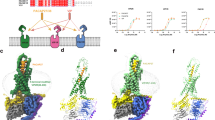Abstract
Increasing evidence exists that growth and proliferation as well as the functional properties of various cells are regulated by a complex network of cytokines and by peptide interactions. VIP is a 28-amino acid neuroendocrine mediator with a broad range of biologic activities in diverse cells and tissues. VIP is a vasodilatory substance responsible for the watery diarrhea syndrome in patients with VIP-secreting tumors. More recent studies suggest that in addition, VIP promotes cell growth and proliferation. The effects of VP are mediated via cell surface membrane receptors which are widely distributed throughout the gastrointestinal tract, but are also found on various immune cells. SST is a 14-amino acid peptide acting as a neurotransmitter or as a hormone, depending on the site of action and target cell type. In contrast to VIP, SST inhibits cell growth and proliferation. We have analyzed the in vitro (and in vivo) biodistribution and receptor binding of 123I-labelled VIP and of 123I-labelled octreotide (long-acting SST analog, OCT). Furthermore, possible interactions between VIP and SST (and its analogs) were analyzed. Significant cross-competition between VIP and SST/OCT for binding onto endothelial cells (HUVEC), basophils (KU812 cells), mast cells (HMC1 cells), peripheral blood monocytes and a variety of primary tumor cells and tumor cell lines (PANC1, A431, HT29, COLO320) was observed. The rank-order of potency for displacement of 123I-VIP binding to intact endothelial cells was VIP (3.8 nM) > OCT (IC50=12.9 ± 3.2 nM) = SST > substance P = secretin (IC50 = 1 μM). Binding of 123I-Tyr-3-OCT to endothelial cells, in turn, was inhibited by OCT = Tyr-3-OCT (IC50=3.1 ± 1.9 nM) = SST > VIP (IC50=8.2 ± 3.0 nM). This rank-order of potency was also obtained for all other normal and malignant cells investigated.
Access this chapter
Tax calculation will be finalised at checkout
Purchases are for personal use only
Similar content being viewed by others
Author information
Authors and Affiliations
Editor information
Editors and Affiliations
Rights and permissions
Copyright information
© 1996 Plenum Press, New York
About this chapter
Cite this chapter
Virgolini, I. et al. (1996). Cross-Competition Between Vasoactive Intestinal Peptide (VIP) and Somatostatin (SST) for Binding to Specific Receptors Expressed on Endothelial Cells, Basophils, Mast Cells and Monocytes: Pathophysiology and Clinical Implications. In: Catravas, J.D., Callow, A.D., Ryan, U.S. (eds) Vascular Endothelium. NATO ASI Series, vol 281. Springer, Boston, MA. https://doi.org/10.1007/978-1-4613-0355-8_80
Download citation
DOI: https://doi.org/10.1007/978-1-4613-0355-8_80
Publisher Name: Springer, Boston, MA
Print ISBN: 978-1-4613-8013-9
Online ISBN: 978-1-4613-0355-8
eBook Packages: Springer Book Archive




